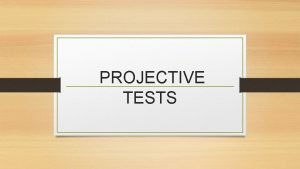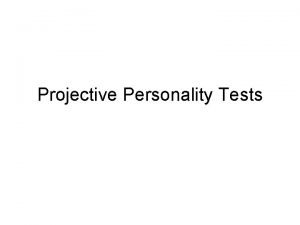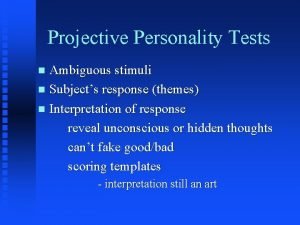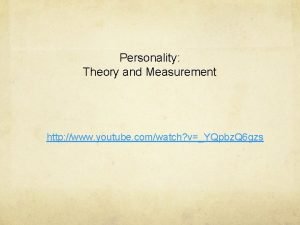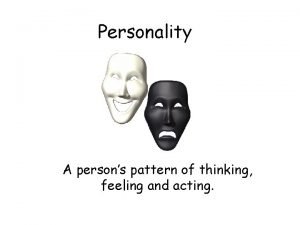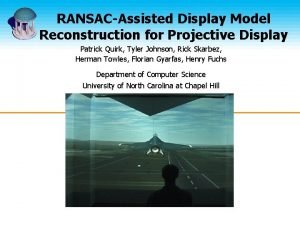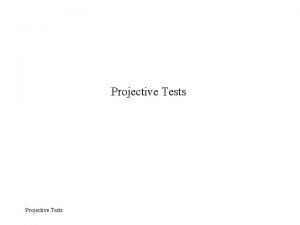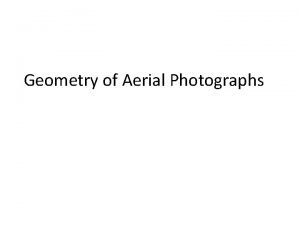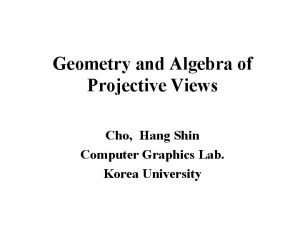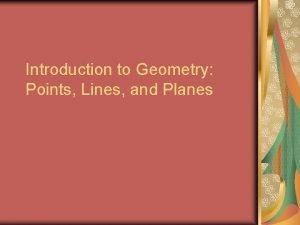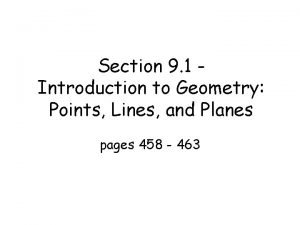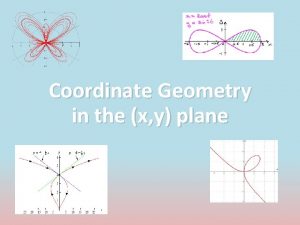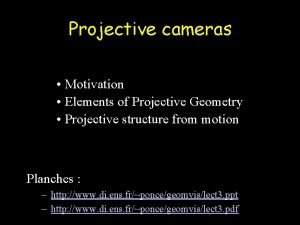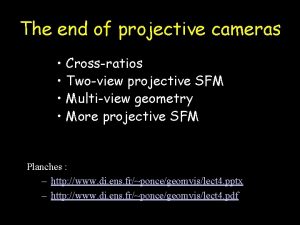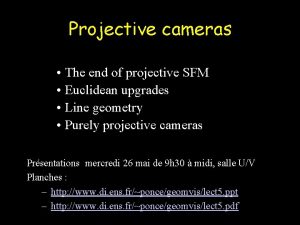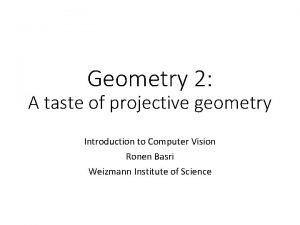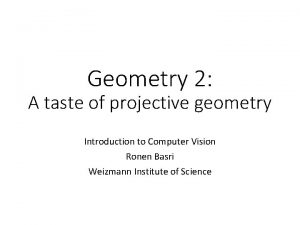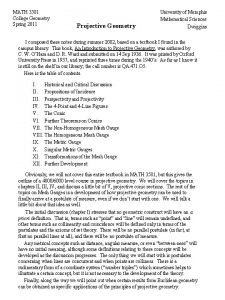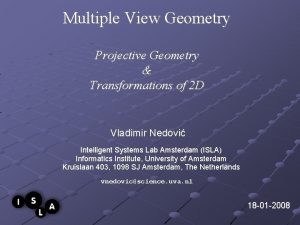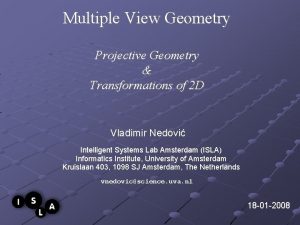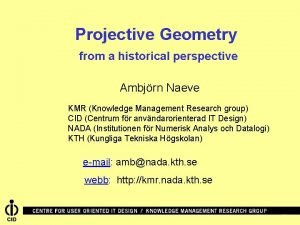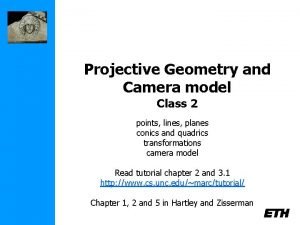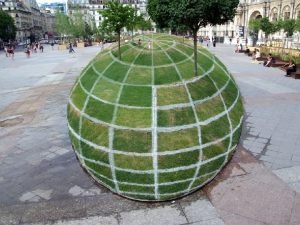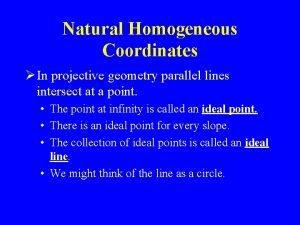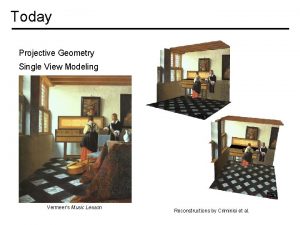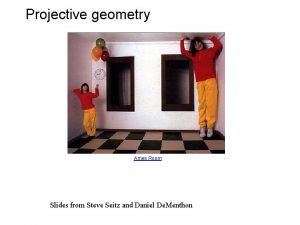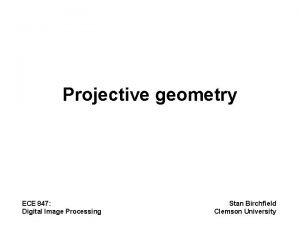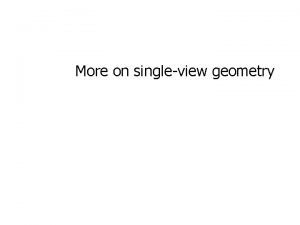Geometry 1 Perspective model projective geometry Introduction to





































- Slides: 37

Geometry 1: Perspective model, projective geometry Introduction to Computer Vision Ronen Basri Weizmann Institute of Science

Perspectivity

Material covered • Pinhole camera model, perspective projection • A taste of projective geometry • Homography (planes, camera rotation) • Two view geometry, general case: • Epipolar geometry, the essential matrix • Camera calibration, the fundamental matrix • Stereo vision • 3 D reconstruction from two views • Multi-view geometry, reconstruction through factorization



Trillion frames per second (Velten, Raskar and Bawendi 2011)


Camera obscura (“dark room”) "Reinerus Gemma-Frisius, observed an eclipse of the sun at Louvain on January 24, 1544, and later he used this illustration of the event in his book De Radio Astronomica et Geometrica, 1545. It is thought to be the first published illustration of a camera obscura. . . " (Hammond, John H. , The Camera Obscura, A Chronicle)

Why not use a pinhole camera? • Pinhole cameras are dark • Pinhole too big – blurry image • Pinhole too small – diffraction

Lenses

Lenses • Lenses collect light from a large hole and direct it to a single point • Overcome the darkness of pinhole cameras • But there is a price • • Focus Radial distortions Chromatic abberations … • Pinhole is useful as a geometric model • Perspective: “perspicere” (latine) – to see through

Pinhole camera model

Perspective projection

Perspective projection O – Focal center π – Image plane Z – Optical axis f – Focal length

Perspective projection

Perspective projection •

Orthographic projection • When objects are far from the camera • Projection rays are nearly parallel • Camera center at infinity

Scaled orthographic How would a tilted rectangle look like under perspective projection? And under scaled orthography?

Which projection model should I use? • Perspective model is needed • In scenes that contain many depth differences • For accurate 3 D reconstruction (stereo, structure from motion) • Scaled orthographic can be used • When objects are small relative to their distance from the camera • Often sufficient for recognition applications

Geometry • Geometry – Greek: earth measurement • Geometry concerns with shape, size, relative positions, and properties of spaces • Euclidean geometry: • • • Point, line, plane Incidence Continuity Order, “between” Parallelism Congruence = invariance: angles, lengths, areas are preserved under rigid transformations

Projective geometry • How does a plane looks after projection? How does perspective distorts geometry?

Plane perspective Pencil of rays

Plane perspective Pencil of rays

Projective transformation

Projective transformation • How these change from Eucleadian geometry? • • • Point, line, plane Incidence Continuity Order, “between” Parallelism Congruence • Under projective transformation • A (straight) line transforms to a line and a conic to a conic • But order and parallelism are not preserved • Likewise, angles, lengths and areas are not preserved

Projective coordinates •

Projective line •

Intersection and incidence •

Ideal points •

Line at infinity

Line at infinity •

Homography •

Homography •

Hierarchy of transformations Rigid Preserves angles, lengths, area, parallelism Similarity Preserves angles, parallelism Affine Preserves parallelism Homography Preserves cross ratio

Camera rotation •

Planar scene •

Summary Homography Perspective (calibrated) Perspective (uncalibrated) Orthographic One-to-one (group) Concentric epipolar lines Parallel epipolar lines Form Properties DOFs 8(5) 8(7) 4 Eqs/pnt 2 1 1 1 Minimal configuration 4 5+ (8, linear) 7+ (8, linear) 4 Depth No Yes, up to scale Yes, projective Affine structure (third view required for Euclidean structure)
 Projective geometry
Projective geometry One point perspective house
One point perspective house Silo perspective vs business process perspective
Silo perspective vs business process perspective Social cognitive unit of personality
Social cognitive unit of personality Projective testing
Projective testing Personality test
Personality test Tests that present ambiguous stimuli
Tests that present ambiguous stimuli Projective testing
Projective testing Objective personality
Objective personality Rorschach test meanings
Rorschach test meanings Object relations
Object relations What's labeling theory
What's labeling theory Conclusive research
Conclusive research Identification (defense mechanism)
Identification (defense mechanism) Projective test example
Projective test example Raymond cattell ap psychology
Raymond cattell ap psychology Intuitive projective faith
Intuitive projective faith Advantages and disadvantages of projective tests
Advantages and disadvantages of projective tests Projective monitor
Projective monitor Projective monitor
Projective monitor Publicité mécaniste
Publicité mécaniste What is projective listening
What is projective listening Advantage of focus groups
Advantage of focus groups Psychodynamic causes of schizophrenia
Psychodynamic causes of schizophrenia Rorschach brad pitt
Rorschach brad pitt Projective techniques of data collection
Projective techniques of data collection Personality test greek
Personality test greek Geometry of vertical photograph
Geometry of vertical photograph Homogeneous coordinates vs cartesian coordinates
Homogeneous coordinates vs cartesian coordinates Lewis dot structure and molecular geometry
Lewis dot structure and molecular geometry Electron domain geometry vs molecular geometry
Electron domain geometry vs molecular geometry Covalent bond order
Covalent bond order Plane geometry real life example
Plane geometry real life example Section 1 introduction to geometry answers
Section 1 introduction to geometry answers Xy coordinates
Xy coordinates Mercantile process model from merchants perspective ppt
Mercantile process model from merchants perspective ppt Weak perspective camera model
Weak perspective camera model Concentric zone model image
Concentric zone model image




